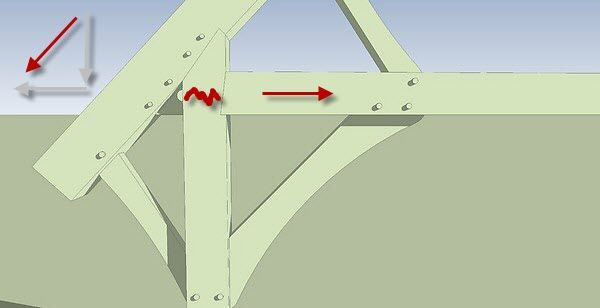Posted By: mo
Principal Rafter Tie Connection - 01/05/11 10:29 PM
Howdy,
Since it has been slow, I figured I would show you all one of my funky designs. Its a real doozy, but that's not the reason for showing.
I really want to get some feedback on the joint in the subject line. Now I know with most trusses you would want your compression member (principal rafter) terminating into your tension member (tie beam).
I haven't done that. Without getting too analytical with loads and such, I would like to just get some intuitive feedback. Here is a picture of the bent/truss arrangement:

The Nancy character (think that's her name) gives enough of the scale and span without providing a bunch of dimensions. One other variable would be a common rafter roof system, no purlins landing on the prafters.
I was thinking a through tenon of substantial thickness. A housing in the prafter to give additional bearing on the tie.
Here is a close up of the arrangement:

And another showing the tenon. No tenons were drawn on braces.

What do you think? Has anyone framed like this before?
RSS to the rescue?
Since it has been slow, I figured I would show you all one of my funky designs. Its a real doozy, but that's not the reason for showing.
I really want to get some feedback on the joint in the subject line. Now I know with most trusses you would want your compression member (principal rafter) terminating into your tension member (tie beam).
I haven't done that. Without getting too analytical with loads and such, I would like to just get some intuitive feedback. Here is a picture of the bent/truss arrangement:

The Nancy character (think that's her name) gives enough of the scale and span without providing a bunch of dimensions. One other variable would be a common rafter roof system, no purlins landing on the prafters.
I was thinking a through tenon of substantial thickness. A housing in the prafter to give additional bearing on the tie.
Here is a close up of the arrangement:

And another showing the tenon. No tenons were drawn on braces.

What do you think? Has anyone framed like this before?
RSS to the rescue?


